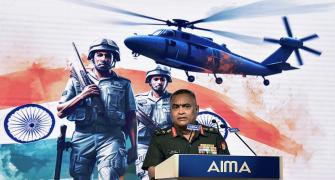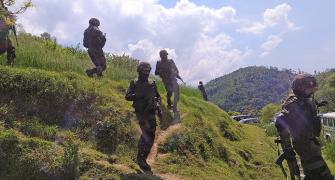The terror masterminds had a simple agenda: An 'Indian' feel to the 'misinterpreted concept of jihad'.
Intelligence Bureau officers now confirm that the Jaipur, Bengaluru and Ahmedabad blasts were planned jointly by the Lashkar and Harkat at the Kotli meeting.
The decision to trigger a series of blasts across India, within a short span of time, was taken at the meeting.
Both the Lashkar and Harkat decided it was once again time to prove a point -- that they still had the upper hand over India's security agencies.
At the same time, the Students Islamic Movement of India, which was playing the role of executor, was facing considerable heat from the agencies. The Harkat and Lashkar deemed it safe to carry out the attack under the signature of the Indian Mujahideen.
Although the name of this outfit has floated around since the serial blasts in Uttar Pradesh, security agencies did not take it too seriously, terming it a hoax.
Three men, instead of a single commander, would be in charge of the operation, it was decided at the Kotli meeting, say Intelligence Bureau sources. The Lashkar, Harkat and ISI agreed that it was too dangerous to entrust one man with charge of the entire operation. They had learnt their lesson after Shahid Bilal became synonymous as the face of terror in India.
Bilal had carried out several terror attacks successfully -- including the blasts at Mecca Masjid, Hyderabad, Ajmer.
Security agencies believe that the Jaipur, Bengaluru and Ahmedabad blasts were undertaken by Mufti Sufiyan, Rasool Khan and Sohail Khan respectively.
The three men, who were allegedly behind the Haren Pandya murder, were directed to split into three groups and undertake the operations, and to operate as the Indian Mujahideen.
Although the initial plan was to use RDX in the attacks, they decided against it since smuggling the explosive was both time-consuming and cumbersome.
Since it was necessary to strike soon and in quick succession, the terror outfits agreed to put together explosives using materials available in the market.
According to the IB, after Saturday's Ahmedabad blasts the three men have all fled to Pakistan, where they had sought refuge immediately after the Haren Pandya murder in March 2003 as well. When the heat was off they had returned to India and lived under various pseudonyms, focusing primarily on recruiting Muslim youth for their terror mission, till July 26.
IB reports suggest the trio had imparted preliminary training to over 29 youth, before sending them to Pakistan for further indoctrination. The youths were taught to handle explosives, use e-mail and browse the Internet.







